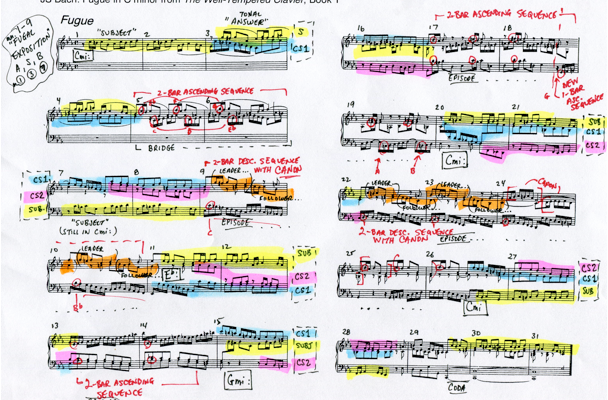


In order to analyze, appreciate and comprehend the musical form called fugue, one must first know the various elements that comprise a fugue.
Every fugue has its own individual characteristic, which display a full range of human emotions. From peacefulness and tranquility to anguish and despair. JS Bach used rhythms, motives as well as melodies and harmonic movement to capture all of these human emotions. Bach used the temperaments of the different keys to establish the mood of each prelude and fugue. These same tonalities are also clearly defined in his choral works as well. Bach was acutely aware of symbolism in art and religion and used it extensively in his works and was well aware of the subtle subliminal effect it has on the listener in addition to the harmonic progressions, melodic intervals, rhythmic motives and patterns.
Bach very adept in the understanding of numerical symbolism, used numerical codes…
View original post 445 more words
Practice Tips for Developing a Solid Technique in Piano Performance
Practicing is both an art and a science. Every student of piano performance must remember that their achievement on the instrument will be the direct result of the amount of time and the quality of their practicing.
The art and science of practicing is not just time spent at the instrument but time spent listening to the music the student is working on, studying and understanding the harmonic analysis of the music as well as researching the time period and technical characteristics of the composer of the piece you are working on.
In addition to this, it is advisable for the student to prepare a weekly plan outlining the time spent on specific techniques, repertoire, sight-reading and review of old or previously learned repertoire.
Technique
The purpose of technique is to serve the pianist’s imagination and realize his/her interpretive ideas…
View original post 201 more words
This year, I’ve finally decided to learn Chopin’s mighty first ballade in G minor. I played his (slightly easier) third ballade in A-flat major a few years ago, and have wanted to take on this iconic beast for quite some time, though have been advised against learning such a well known piece for examinations. But now my LTCL diploma is safely out of the way, and the FTCL feels a long, long way away (if ever…), the time has finally come to tackle the first ballade. Entirely co-incidentally, Alan Rusbridger – editor of the Guardian and amateur pianist – recently published a book about learning the same piece, which of course I devoured with great gusto!
So, aside from the enormous technical challenges of the ballade (of which there are a great many!), what are the memorising issues?
Previously associated only with poetry and song, the term ballade was first applied…
View original post 1,055 more words

Learning Strategies for Musical Success

View original post 308 more words

Toccata BWV 915
The toccata an extensive piece intended primarily as a display of manual dexterity written for keyboard instruments reached its apex with Johann Sebastian Bach in the eighteenth century. Johann Sebastian Bach’s seven Toccatas incorporate rapid runs and arpeggios alternating with chordal passages, slow adagios and at least one or sometimes two fugues. The Toccatas have an improvisational feel to them analogous to the fantasia. Unlike the Well Tempered Clavier, English suites, French suites and other sets, Bach himself did not arrange them into a collection. When JS Bach left Weimar the Toccata at that time was out of fashion. They became in vogue again after his death and were organized into a collection. The g minor Toccata is one of the more obscure of the toccatas and has rarely been performed partially due to the extensive second fugue with its many thorny passages of the contrasting gigue rhythm. However, this Toccata has many fascinating effects. It is one of the only pieces by JS Bach that has dynamic markings of piano and forte.
The g minor Toccata opens with a flourish, which leads into an expressive adagio with an improvisational feel. The adagio is interrupted by a lively allegro in the relative major key of Bb which includes concerto-ritornello passages of imitation and solo/tutti passages. A deceptive cadence leads back into the adagio where it was interrupted and then closes the adagio with a perfect authentic cadence in Bb major. This aspect provides a unity to the different movements of the Toccata. The other striking example of unity between movements is the beginning flourish repeated at the end of the second fugue, which leads into a formal closing of the work.
The extended fugue in a gigue has a subject of an ascending sequence combined with a countersubject of driving triplets. The subject of the fugue has twelve expository entries followed by eleven entries. There are inversions, permutations, combinations of minor with major, which is varied by modulating to the subdominant, then to Eb major and then back to the g minor tonic. The vivacious counter subject of driving triplets provides a symmetrical balance.
To learn more about Fugues please read my other Hub: The Art of Fugue
http://jamilasahar.hubpages.com/hub/The-Art-of-Fugue
For More Information on Piano Lessons in Boca Raton or Via Skype: